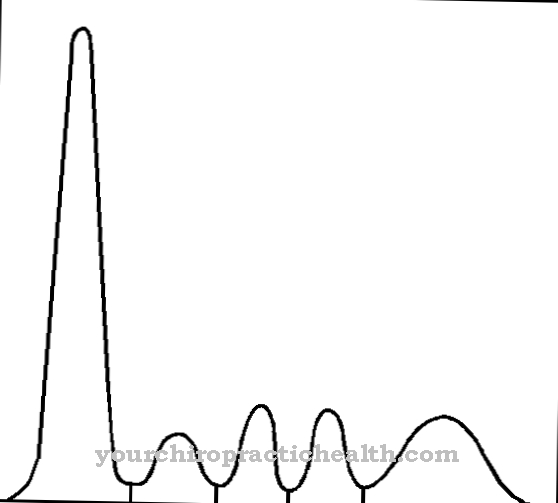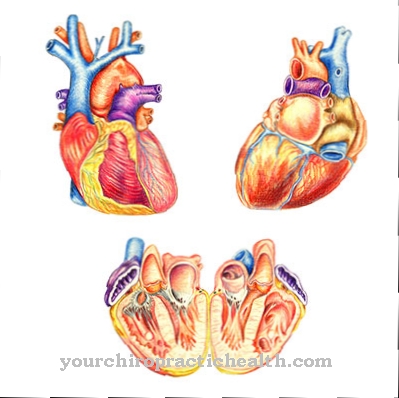Drooping upper eyelids, too Drooping eyelids called, make the face older and make it look tired and exhausted. Often there is also a medical indication when those affected decide to have an operation. From BlepharochalasisAs the medical term for drooping eyelids, men and women are equally affected.
What is blepharochalasis?

© ivandanru - stock.adobe.com
In medicine, drooping eyelids are a misalignment of the upper eyelid: its upper part is bulging and also hangs laterally over the edge of the eyelid. Drooping eyelids occur as acute and recurring swelling of the upper eyelid, which disappears on its own after a certain time. It is permanent in mid-life patients. Drooping eyelids are usually bilateral and can be congenital or a result of the natural skin aging process.
Genetically caused hanging sores that are combined with obesity and goiter are classified under the umbrella term Ascher syndrome. The lowering of the eyelids makes the eyes smaller and the facial expression also changes. The person concerned appears tired, exhausted and older than he actually is. Many patients suffer from it so much that they consider surgical correction of their aesthetic problem.
This is especially true when the unsightly drooping eyelids are added to a lower eyebrow. It is usually also caused by age-related slackening of the connective tissue.
causes
Recurring pain-free eye edema and age-related weakness of the connective tissue slacken the upper eyelid so much that it hangs down. In some cases, fat prolapse, excess tissue in the eye sphincter or paralysis of the fascialis are to blame for the appearance of drooping upper eyelids. With fat prolapse, the fatty tissue in the eyeball pushes out of the eye socket and fills with lymphatic water.
In most cases, however, drooping eyelids are a purely cosmetic problem caused by the loss of elasticity in the skin and the slackening of the connective tissue. Drooping eyelids are particularly pronounced when the eyebrows hang down at the same time. Sometimes even brow ptosis is the sole cause of the aesthetic problem. The appearance of drooping eyelids is also favored by an unhealthy lifestyle: the skin ages faster due to heavy smoking, high alcohol consumption, lack of sleep and stress.
Symptoms, ailments & signs
Drooping eyelids are a major psychological problem, especially for people who value a young and dynamic appearance. They suffer from the fact that their face looks unattractive to other people. The eyelids are often felt to be heavy and cause headaches. In severe cases, the field of vision is even restricted: the direction of view upwards and / or to the side is impaired. The risk of an accident is greater than with people without drooping eyelids.
Diagnosis & course
Anyone who has droopy eyelids that they would like to have surgically removed should first have an ophthalmological examination carried out. The ophthalmologist determines whether the edge of the eyelid is normal and whether there is no weakness of the eyelid lifter muscles (ptosis). He can also find out whether the patient has a neurological disease (fascial paralysis). However, if the eyelids are completely normal, the field of vision is measured: The ophthalmologist determines whether and to what extent it is restricted.
Complications
There are usually no complications with blepharochalasis. This symptom is almost exclusively a cosmetic problem that does not necessarily have to be treated. In many cases, however, the patient is not satisfied with their appearance. This can lead to depression and decreased self-esteem, which is especially common in younger people.
The depression often leads to stress and headaches. In some cases, the eyelids can be so heavy that they also lead to headaches. Only rarely do defects in the visual field occur, which lead to further complications. Those affected usually have a limited field of vision and are therefore exposed to a higher risk of accidents.
Treatment is possible through cosmetic surgery. A tightening is carried out, which, however, has to be repeated again and again. There are no complications. After the surgery, there is swelling and slight pain. These disappear after a few days. A wound does not remain. However, it takes about a month before the patient can see the result of the operation.
When should you go to the doctor?
With blepharochalasis, a doctor does not have to be consulted in every case. In most cases, a visit to the doctor is only necessary if the person concerned feels uncomfortable with this complaint or if the patient's field of vision is restricted by the disease. In many cases, the risk of various accidents due to blepharochalasis can increase, so that treatment should be carried out especially in children or the elderly so that there are no further complications or consequential damage.
A doctor must also be consulted if blepharochalasis leads to psychological complaints or depression. It is not uncommon for those affected to suffer from inferiority complexes or from reduced self-esteem. A visit to a doctor is also recommended here.
Further treatment is usually based on the underlying disease and can be carried out by an ophthalmologist. In the case of psychological complaints, a psychologist should be consulted so that the symptoms of blepharochalasis can be completely limited.
Doctors & therapists in your area
Treatment & Therapy
The patient can surgically remove the drooping eyelids with an upper eyelid tightening (blepharoplasty) or be injected with botox. He can also undergo a radiage. The most common method is upper eyelid tightening. It takes place on an outpatient basis with a scalpel or laser and is carried out by a specialist in aesthetic plastic surgery.
Ideally, he has several years of experience in the field of eyelid tightening. The patient can request relevant information from the responsible medical association. With the upper eyelid tightening, the excess skin and part of the fatty tissue are cut out directly in the crease of the lid. Sometimes a part of the lid closing muscle is removed. The suture is placed in the fold of the envelope so that the scar is later invisible. On the side it is covered by the crow's feet anyway.
The 60-minute surgical procedure is performed under local anesthesia. If the operation proceeds normally, the bruising and swelling around the eyes will not be visible for more than a week. If the procedure is performed correctly, secondary bleeding rarely occurs. Lower browbones can be injected with Botox. However, this cosmetic surgical treatment has to be repeated every 3 to 6 months, as the botulinum toxin is temporarily broken down by the body.
With the new type of Radiage, the upper eyelid tissue is heated with the help of radio frequency technology, so that the collagen stored in the skin contracts and the swelling goes down. Radiage, which is carried out on an outpatient basis in 30 to 60 minutes and is also much cheaper, has the advantage that the patient can go back to work immediately after the operation.
Depending on the condition of the skin, several treatments may be necessary. The slight redness in the eye area often disappears within 24 hours. The final result can be seen in a few months at the latest. The radiage should be repeated after one to three years.
Outlook & forecast
The prognosis for blepharochalasis is favorable. Many people decide not to have medical treatment because the procedure is more a visual improvement than a physical necessity. There are no restrictions on the functionality of the body with blepharochalasis. The eyesight remains undiminished despite the drooping eyelid. Nevertheless, emotional and mental stress can occur due to the optical flaw.
For this reason, corrective treatment can be carried out in a surgical procedure. The operation is a one-hour routine procedure with a subsequent prospect of healing and freedom from symptoms. However, the treatment is associated with the usual risks and side effects of surgery. It can lead to complications and problems with wound healing. These lengthen the healing path. With a healthy and balanced diet, the person affected can specifically support the healing success.
If a patient decides to undergo cosmetic correction by injecting Botox, there is no permanent relief from the symptoms. Blepharochalasis will gradually return within a few months until it is completely back after 6 months. The treatment then has to be repeated.
With special creams, massages or training of the facial muscles, the patient can independently take preventive measures. It also supports the healing success after a treatment.
prevention
In order to prevent the appearance of drooping eyelids caused by slackening of the connective tissue, it is advisable to stay as healthy as possible. Sufficient sleep, not too much stress, at least limited consumption of nicotine and alcohol, and sleeping with an elevated upper body can help prevent the cosmetic problem from occurring at all or only after a delay. Treating the eye area with certain eye creams recommended by the cosmetics industry cannot prevent drooping eyelids.
Aftercare
In the case of blepharochalasis, follow-up care is usually neither necessary nor possible. The affected person is dependent on a surgical procedure, which usually proceeds without complications and completely alleviates the symptoms of the disease. The life expectancy of the person affected is also not negatively influenced or reduced by blepharochalasis.
After surgery, the person affected should rest and take care of their body. In doing so, strenuous activities or sporting activities should be avoided. Unnecessary efforts and stressful situations should also be avoided. In general, a healthy lifestyle with a healthy diet and regular exercise also has a very positive effect on the further course of the disease and can accelerate healing.
In most cases, the reddening of the eye also disappears relatively quickly, so that there are no particular aesthetic restrictions. In some cases, however, blepharochalasis can lead to psychological complaints or depressive moods. Conversations with friends and acquaintances help, whereby contact with other people affected by the disease can also prove useful. In most cases, however, another intervention is necessary after three years to completely relieve the symptoms.
You can do that yourself
Blepharochalasis is usually a purely cosmetic problem, but those affected can also do something about it themselves. Drooping eyelids make a person look sleepy and exhausted and can distort all facial expressions in a pronounced form. When the disorder is accompanied by lowering of the eyebrows, many people feel downright disfigured.
The best form of self-help against blepharochalasis are preventive measures that counteract premature skin aging. Healthy, low-fat, vitamin and fiber-rich diet, adequate sleep and regular exercise, preferably in the fresh air, are beneficial. On the other hand, nicotine consumption, excessive alcohol consumption, a low-nutrient diet, lack of exercise and obesity have a negative effect.
If drooping eyelids have already formed, they can be combated in the initial stage with simple home remedies and cosmetics. If you suffer from puffy eyes and drooping eyelids, especially in the morning, you should wrap an ice cube in a paper napkin and place it on the eyes, which has a decongestant effect. Eye rollers and eye creams that have a cooling and decongestant effect are also available in cosmetic stores.
The right eye make-up can optically hide the drooping eyelids and make them less noticeable. Those affected can learn appropriate make-up techniques from a trained beautician.
In severe cases, especially if those affected are also suffering from their blemish mentally, they should consult a plastic surgeon and consider surgical correction.


.jpg)
.jpg)


.jpg)




















